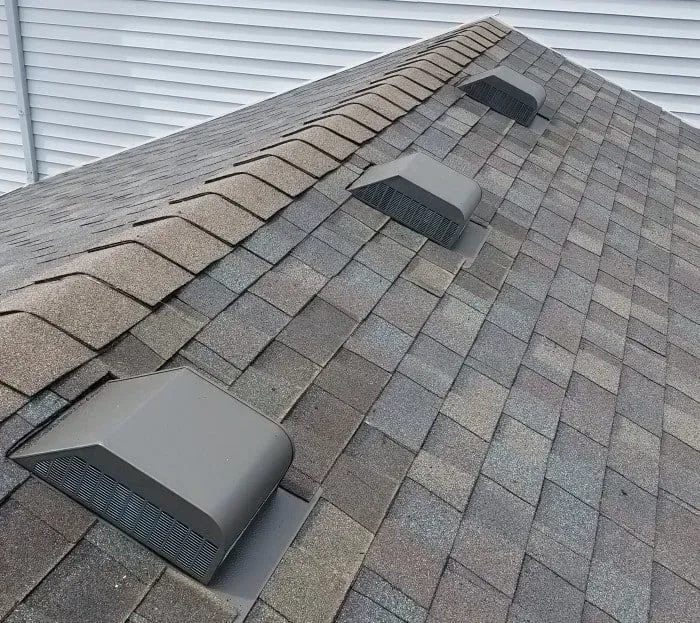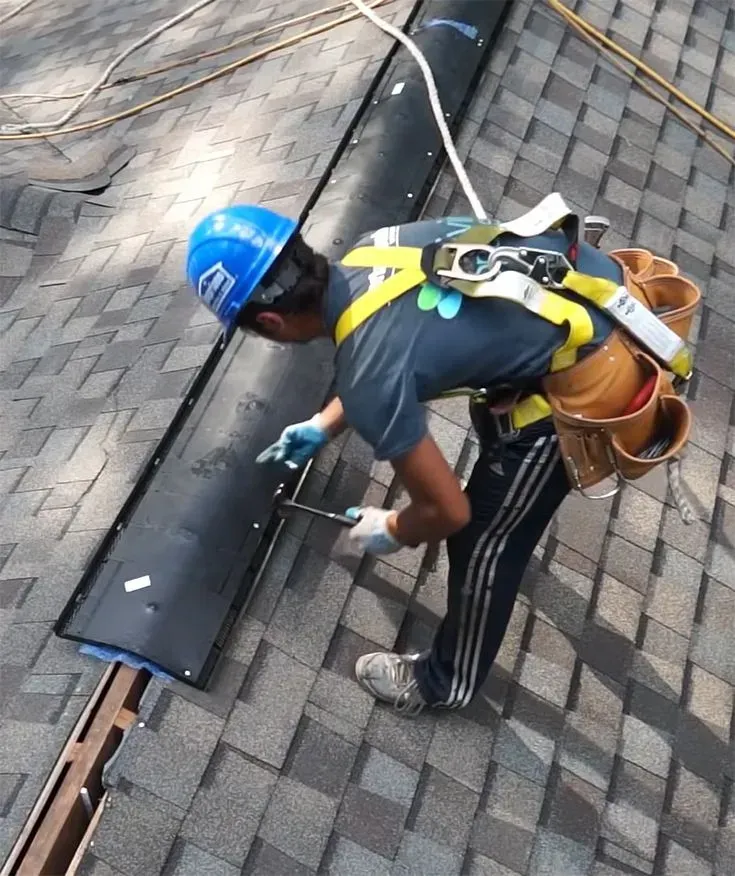Roof Ridge Vent Installation Service in Washington DC
At Washington DC Roofing Company, we specialize in professional roof ridge vent installation services to enhance your home's ventilation system and protect your investment. A properly installed ridge vent can save homeowners between 10-30% on energy costs while extending roof life by preventing moisture damage and reducing attic temperatures.
The Mid-Atlantic region's climate creates unique challenges for home ventilation—hot, humid summers and cold winters place significant stress on roofing systems when attic airflow is inadequate. Our ridge vent solutions address these specific regional concerns by creating a balanced ventilation system that works year-round to regulate temperature and humidity levels throughout your attic space.
Ridge vents represent the most effective type of roof ventilation, utilizing the natural physics of air convection to create continuous airflow without mechanical components that can fail. Unlike traditional box vents or powered ventilators, ridge vents distribute ventilation evenly across the entire roof line, eliminating hot spots and moisture accumulation that lead to premature shingle deterioration and structural damage.
Beyond energy savings and roof life extension, our ridge vent installations provide additional benefits including reduced indoor temperature fluctuations, decreased HVAC system strain, and minimized risk of ice dam formation during winter months. This comprehensive approach to ventilation delivers both immediate comfort improvements and long-term protection for your home.

The Basics of Roof Ridge Vents
Roof ridge vents serve as critical components in maintaining proper attic ventilation, helping maintain optimal temperature control and extending roof life.
Function and Benefits
Ridge vents create a continuous air exchange along the peak of the roof, drawing hot air and moisture out of the attic space. This ventilation helps prevent ice dams in winter and reduces cooling costs in summer.
We've found that properly installed ridge vents can reduce HVAC energy consumption by balancing indoor temperatures throughout the year.
These vents also protect roofing materials from premature deterioration by preventing moisture buildup that can lead to mold and rot.
Types of Roof Ridge Vents
Shingle-Over Ridge Vents
- Blend seamlessly with existing roof shingles
- Provide maximum weather protection
- Most popular choice for residential homes
Metal Ridge Vents
- Highly durable construction
- Ideal for harsh weather conditions
- Enhanced resistance to snow and rain infiltration
Externally Baffled Vents
- Include external weather filters
- Superior protection against wind-driven precipitation
- Work effectively in areas with frequent storms
We recommend shingle-over ridge vents for most residential applications due to their aesthetic appeal and reliable performance.
Our Installation Process
At Washington DC Roofing Company, we follow a meticulous and proven process for ridge vent installations that maximizes ventilation efficiency while ensuring long-term durability.
Initial Inspection and Consultation
Our certified technicians begin with a thorough examination of your existing roof structure and ventilation system. We measure your attic space and calculate the required ventilation based on your home's square footage and local building codes.
We inspect the current ridge board condition and evaluate the surrounding shingles. This helps us identify any potential issues that need addressing before installation.
A detailed assessment of your attic's current airflow patterns allows us to determine optimal vent placement. We document temperatures and moisture levels to establish baseline measurements.


Customized Installation Plan
We create a detailed project blueprint tailored to your roof's specific requirements. This includes selecting the appropriate ridge vent style and materials that match your existing roofing system.
Our team maps out precise measurements and cutting locations along the ridge. We calculate the exact amount of ventilation needed to balance intake and exhaust airflow.
The plan incorporates weather considerations and timeline coordination to ensure minimal disruption to your daily routine.
Professional Implementation
We start by carefully removing existing ridge caps and creating a continuous vent slot along the peak. Our team uses specialized equipment to ensure precise cuts that meet manufacturer specifications.
Installation begins with proper underlayment preparation and weather stripping application. We secure the ridge vent using corrosion-resistant fasteners at manufacturer-recommended intervals.
The final step involves installing new ridge caps over the vent system. We conduct a thorough inspection to verify proper installation and optimal airflow performance.

Maintenance and Care
Our installation process incorporates infrared moisture detection to identify potential weak points before they become problems. This technology allows us to map your roof's moisture levels with precision.
We apply robotically-measured adhesive patterns that ensure optimal material bonding and reduce the risk of wind uplift. The computer-controlled application creates consistent coverage every time.
Our team uses digital imaging software to calculate precise measurements and determine the most effective drainage patterns for each roof's unique geometry. This maximizes water flow efficiency.
Regular maintenance of your roof ridge vent system helps ensure optimal performance and longevity. We recommend inspecting your ridge vents at least twice per year, particularly before winter and after severe storms.
Keep the vent channels clear of debris like leaves, twigs, and dirt. A quick visual inspection can identify any blockages that need cleaning. Use a leaf blower or soft brush to gently remove accumulated debris.
Key maintenance tasks include:
- Checking for loose fasteners or damaged shingles near the vent
- Ensuring proper sealing around vent edges
- Removing any pest nests or intrusions
- Inspecting interior attic for signs of moisture
If you notice any damaged components or improper functioning, contact us promptly for professional repairs. Small issues can escalate into bigger problems if left unaddressed.
We also advise monitoring your attic temperature and humidity levels periodically. A properly functioning ridge vent system should maintain consistent ventilation throughout the seasons.
During winter months, check that snow accumulation isn't blocking the vents. While our installations are designed to prevent most snow infiltration, extreme weather conditions may require attention.
Professional cleaning and maintenance services are available through our team at Washington DC Roofing Company. We can thoroughly inspect your system and address any concerns before they become serious issues.

FAQs
TPO roofing installations come with many common questions from our customers. We've gathered the most important information about costs, durability, brands, and maintenance to help you make informed decisions.
What are the factors influencing the cost of a TPO roof installation?
Several key elements affect TPO roofing costs. The size of your roof is the primary factor, as larger areas require more materials and labor.
The thickness of the TPO membrane impacts pricing significantly. We offer options ranging from 45 mil to 80 mil thickness, with thicker membranes costing more but providing enhanced durability.
Your roof's complexity matters too. Buildings with multiple penetrations, HVAC units, or unusual shapes require more detail work and flashing.
Accessibility affects labor costs. If your roof is difficult to reach or requires special equipment, this will increase the installation price.
How long does a TPO roof typically last under normal weather conditions?
TPO roofs installed by Washington DC Roofing Company typically last 20-30 years with proper maintenance. This lifespan depends on several factors including membrane thickness and local climate conditions.
The quality of installation significantly impacts longevity. Our certified installation team ensures all seams are properly welded and details are correctly finished.
Modern TPO formulations have improved UV and heat resistance compared to earlier generations. This enhancement helps maintain reflectivity and structural integrity over time.
Regular inspections can help identify and address small issues before they compromise the roof's lifespan.
Which TPO roofing brand shows the highest performance and reliability?
We primarily install GAF and Firestone TPO systems due to their consistent performance records and extensive warranties. These manufacturers have refined their formulations over decades.
GAF EverGuard TPO offers excellent heat and UV resistance with their advanced material science. Their products perform exceptionally well in Washington DC's varying climate conditions.
Firestone UltraPly TPO provides superior puncture resistance and flexibility, maintaining performance through seasonal temperature changes. Their seam strength is among the industry's best.
Both brands offer comprehensive warranty options that can extend up to 30 years when installed by certified contractors like us.
Are there any notable drawbacks when using TPO roofing for commercial buildings?
Installation quality is critical with TPO systems. Poorly welded seams can lead to leaks and premature failure, which is why we invest in ongoing training for our installation teams.
Some older TPO formulations had issues with premature aging and cracking. Today's improved materials have largely resolved these concerns, but choosing a quality manufacturer remains important.
TPO can be punctured by sharp objects, making regular roof inspections necessary. We recommend establishing maintenance protocols after installation.
While highly energy efficient, TPO's initial cost may be higher than some traditional roofing systems, though this is typically offset by energy savings over time.
Can a TPO roof be installed over an existing roofing system, and what are the considerations?
Yes, in many cases we can install TPO over existing roofing, potentially saving on removal costs and reducing landfill waste. This approach is called a "recover" installation.
The existing roof must be structurally sound and relatively dry. We conduct moisture scanning to detect any trapped water that could compromise the new system.
Building codes typically limit commercial buildings to two roof layers. We'll verify local regulations and assess your current roofing situation during consultation.
Proper preparation may include adding recovery board insulation to create a smooth, compatible surface for the new TPO membrane attachment.
Tell Us About Your Roofing Project
Contact Us
Our Newsletter
We will get back to you as soon as possible.
Please try again later.
Subscribe For Newsletter
All Rights Reserved | Washington DC Roofing Company
